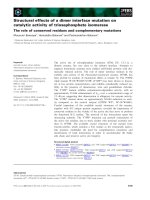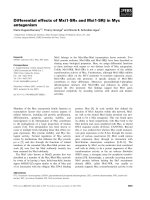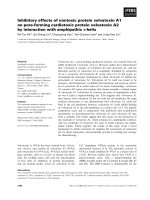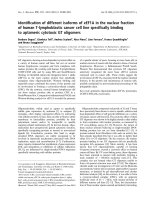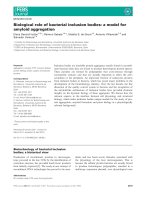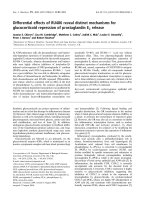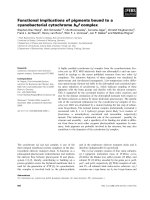Báo cáo khoa học: "The effects of different weaning modes on the endocrine stress respons" potx
Bạn đang xem bản rút gọn của tài liệu. Xem và tải ngay bản đầy đủ của tài liệu tại đây (54.1 KB, 4 trang )
Available online />Research
The effects of different weaning modes on the endocrine stress
response
Guniz Meyanci Koksal
1
, Cem Sayilgan
1
, Oznur Sen
2
and Huseyin Oz
3
1
Senior Resident, Department of Anaesthesiology and Reanimation, Istanbul University Cerrahpasa Medical Faculty, Istanbul, Turkey
2
Resident, Department of Anaesthesiology and Reanimation, Istanbul University Cerrahpasa Medical Faculty, Istanbul, Turkey
3
Professor, Department of Anaesthesiology and Reanimation, Istanbul University Cerrahpasa Medical Faculty, Istanbul, Turkey
Correspondence Guniz Meyanci Koksal,
Introduction
Intubation and mechanical ventilation are safe and effective
treatments for critically ill patients with respiratory failure [1].
However, while unnecessary prolongation of mechanical ven-
tilation increases the risk of complications, including bron-
chopulmonary infections, barotrauma, and oxygen toxicity, its
premature discontinuation may also increase morbidity and
mortality. Intensive care can indeed be prolonged if reintuba-
tion is needed [2,3]. ‘Weaning’ is the withdrawal of mechani-
cal ventilatory support, although the term ‘liberation’ may be
more appropriate [4]. Selection of the most appropriate mode
for weaning can be difficult [5].
The effect of weaning on the stress response in critically ill
patients is uncertain, as are the effects of different weaning
modes. The aim of the present study was to compare changes
in plasma concentrations of insulin, cortisol and glucose, and
in urine vanilmandelic acid (VMA) during weaning and after
extubation, using the three different modes of pressure
support (PS) ventilation, continuous positive airway pressure
(CPAP) and T-piece, in intensive care patients.
R31
CPAP = continuous positive airway pressure; FiO
2
= fractional inspired oxygen concentration; PaO
2
= partial arterial oxygen tension; PS =
pressure support; VMA = vanilmandelic acid.
Abstract
Introduction The aim of the present study was to investigate the effects of the stress response on
plasma insulin, cortisol, glucose, and urinary vanilmandelic acid during weaning and after extubation,
using pressure support (PS), continuous positive airway pressure (CPAP) and T-piece modes.
Methods Sixty patients were randomly divided into three groups (n = 20). The PS group received
FiO
2
≤ 0.4, PS ≤ 10 cmH
2
O, and positive end expiratory pressure ≤ 5cmH
2
O for 2 hours. The CPAP
group was given FiO
2
≤ 0.4 and CPAP ≤ 5 cmH
2
O for 2 hours. The T-piece group (group T) received
4 l/min oxygen via a T-piece for 2 hours. After 1 hour and 2 hours in their respective weaning modes,
blood and urine samples were taken for insulin, cortisol, glucose and vanilmandelic acid
measurements. Forty-eight hours after extubation, blood and urine samples were again taken.
Results Plasma insulin was greater in group T than in the PS and CPAP groups (P < 0.01 and
P < 0.01). The plasma cortisol concentration was greater in group T than in group PS during weaning
(P < 0.05) and after extubation (P < 0.05). Blood glucose concentrations were greater in group T than
in the other groups (both P < 0.01) both during weaning and post extubation. Urine vanilmandelic acid
was greater in group T than in the other groups during weaning and after extubation (both P < 0.001).
Conclusion Weaning via the T-piece caused a greater stress response than the PS and CPAP modes.
Keywords cortisol, insulin, mechanical ventilation, stress response, ventilation modes, weaning
Received: 3 August 2003
Revisions requested: 26 September 2003
Revisions received: 18 October 2003
Accepted: 10 November 2003
Published: 3 December 2003
Critical Care 2004, 8:R31-R34 (DOI 10.1186/cc2413)
This article is online at />© 2004 Koksal et al., licensee BioMed Central Ltd
(Print ISSN 1364-8535; Online ISSN 1466-609X). This is an Open
Access article: verbatim copying and redistribution of this article are
permitted in all media for any purpose, provided this notice is
preserved along with the article's original URL.
Open Access
R32
Critical Care February 2004 Vol 8 No 1 Koksal et al.
Materials and methods
The study was approved by the Human Studies Review
Board of the Cerrahpasa Medical Faculty of Istanbul Univer-
sity, and informed consent was obtained from the patients’
families. Sixty patients, mechanically ventilated for more than
48 hours, were studied. Their age, gender, and diagnosis at
intensive care admission were recorded. Patients with
endocrine or immune system disease, patients with malignant
disorders, patients who were also receiving insulin, and
patients who were on sympathomimetic agents or steroids
were excluded from the study. Weaning was considered
unsuccessful if reintubation was required within 48 hours,
and these patients were excluded from the study.
We calculated the Acute Physiology and Chronic Health
Evaluation II scores from clinical data available after the first
24 hours of intensive care. All patients received a nasojejunal
tube, and feeding was commenced according to the
Harris–Benedict formula. Entry criteria for the weaning trial
were as follows: positive end expiratory pressure ≤ 5 cmH
2
O,
partial arterial oxygen tension (PaO
2
)/fractional inspired
oxygen concentration (FiO
2
) ≥ 200, the resolution of (or sig-
nificant improvement in) the underlying condition requiring
mechanical ventilation, hemodynamic stability, an adequate
neurological status, an absence of fever, a presence of cough
reflex when on a passing suction catheter, an intact gag
reflex, and an absence of vasopressor or sedative infusions
drips. Dopamine < 5 µg/kg per min was allowed, as were
intermittent doses of sedatives [6]. The criteria for tolerating
weaning trials were PaO
2
≥ 60 mmHg or arterial oxygen satu-
ration ≥90%, or FiO
2
≤ 0.4–0.5, PaCO
2
increase ≤ 10 mmHg
or pH decrease < 0.1, systolic blood pressure ≥ 90 mmHg or
≤ 180 mmHg with any increase or decrease ≤ 20%, heart rate
≥ 50 beats/min or ≤ 140 beats/min with any increase or
decrease ≤ 20%, respiratory rate ≤ 35 breaths/min, and no
sign of excessive respiratory work (absence of thoracoab-
dominal paradox, respiratory alternans or accessory respira-
tory muscle action). No diaphoresis, agitation, depressed
mental status, or distress were present [7].
Patients were ventilated by either the Siemens-Elema Servo
900 C or Servo 300 A ventilators (Siemens-Elema, Solna,
Sweden). Patients were randomly divided into three groups
(each n = 20). Two modes of partial ventilatory support during
the weaning period were employed; group PS received
FiO
2
≤ 0.4, PS ≤ 10 cmH
2
O, and positive end expiratory pres-
sure ≤5cmH
2
O for 2 hours. The CPAP group received
FiO
2
≤ 0.4 and CPAP ≤ 5 cmH
2
O for 2 hours. The T-piece
group (group T) received 4 l/min oxygen via a T-piece for
2 hours. In group T, the mean respiratory rate was
20 breaths/min, the tidal volume was 550–600 ml and the
T-piece reservoir volume was 60 ml, giving a mean FiO
2
of
0.35–0.4. Patients in group PS and in group CPAP were
divided between the two ventilators. Eight patients in group
PS thus received the Servo 900 C ventilator and 12 received
the Servo 300 A ventilator. In the CPAP group, seven
received the Servo 900 C ventilator and 13 received the
Servo 300 A ventilator. An 8.0 mm inner diameter endotra-
cheal tube was used for all patients.
At the beginning of the weaning trial, blood and urine samples
were taken for insulin, cortisol, glucose, VMA and arterial
blood gas measurements (PaO
2
, PaCO
2
, pH). The measure-
ments were repeated at the end of the weaning trial, after
2 hours, when the patients were extubated. Weaning was
considered successful if reintubation was not required within
48 hours. Samples were repeated 48 hours after successful
extubation. Blood pressure was recorded every 2 hours.
The blood samples for measuring the endocrine stress
response were taken between 07:00 and 09:00 am because
of the circadian rhythm. No patient received any medication
that could affect VMA measurement, such as insulin, reser-
pine, norepineprine, epineprine, morphine, or pentobarbital.
Plasma insulin levels were determined using a commercially
available radioimmunoassay (Novo; Nordisk, Copenhagen,
Denmark). Plasma cortisol measurements were measured by a
competitive immunoassay with the use of an electrochemilumi-
nescence immunoassay (ECLIA; Roche, Mannheim, Germany).
VMA concentrations of spot urine samples (2-hour collection)
were determined by chomatographic-spectrohotometric assay
(FAR, Verona, Italy). Blood glucose levels were determined by
Medisense Glucotrend (Behring, Mannheim, Germany).
Statistical analysis
Data are expressed as the mean ± standard deviation. Demo-
graphic and biochemical data were compared between
groups using the Kruskall–Wallis test and, when appropri-
ate, by multiple comparison tests (Dunn test). Within-group
changes were analyzed using repeated analysis of variance.
Differences between groups were considered significant at
P < 0.05. Statistical analysis was performed by the Istanbul
University Cerrahpasa Medical Faculty, Department of Bio-
statistics.
Results
There were no differences between the groups in age,
weight, gender and Acute Physiology and Chronic Health
Evaluation II scores (Table 1), and there were no differences
over time in the heart rate or noninvasive blood pressure, arte-
rial PaO
2
, PaCO
2
, or pH (data not shown). Four patients
required reintubation within 48 hours in group T. Reintubation
was not required within 48 hours in the CPAP and PS
groups. There was no significant difference between groups
according to patients receiving sedatives and according to
sedative doses (data not shown).
Plasma insulin
Plasma insulin concentrations increased in group PS and in
group T (both P < 0.05) during weaning, and in group T after
extubation (P < 0.01) (Table 2). Plasma insulin was greater in
R33
group T than in the other groups after extubation (P < 0.01)
(Table 2).
Plasma cortisol
Plasma cortisol was increased in group CPAP (P < 0.01) and
in group T (P < 0.001) during weaning, and in group T after
extubation (P < 0.01) (Table 3). Concentrations were greater
in group T than in group PS during weaning and after extuba-
tion (both P < 0.05), and were greater in group T than in
group CPAP (P < 0.01) post extubation (Table 3).
Blood glucose
Blood glucose increased during weaning in group PS
(P < 0.05) and in group T (P < 0.01) (Table 4), increasing
more in group T than in group PS and group CPAP (both
P < 0.01). The blood glucose concentration was greatest in
group T post extubation (group PS and group CPAP both
P < 0.05) (Table 4).
Urine VMA
Urinary VMA increased in group PS (P < 0.05) and in group T
(P < 0.001) during weaning, and increased in group CPAP
(P < 0.01) and in group T (P < 0.001) post extubation
(Table 5). Urinary VMA was greatest in group T during both
weaning and post extubation (P < 0.001) (Table 5).
Discussion
Weaning fails in a significant proportion of mechanically venti-
lated patients. The pathophysiology of weaning failure is
complex, multifactorial, and poorly understood [8,9]. We
believe that the stress response may play an important role
during weaning. We therefore measured blood insulin, blood
cortisol and blood glucose, and urinary VMA during and after
weaning in three modes: PS, CPAP and T-piece.
Brinkmann and colleagues found that catecholamine and
stress hormone blood concentrations did not increase follow-
ing withdrawal of sedation and cessation of mechanical venti-
lation after abdominal surgery [10]. Rathgeber and colleagues
used biphasic positive airway pressure, controlled mandatory
ventilation, or intermittent mandatory ventilation for weaning
after cardiac surgery [11]. The hormonal response was not
affected by the discomfort of breathing. Calzia and colleagues
Available online />Table 1
Demographic data in all groups
Group PS Group CPAP Group T
Age (years) 73 ± 13 71 ± 16 75 ± 12
Weight (kg) 61 ± 20 63 ± 21 66 ± 22
Gender (male/female) 9/11 11/9 8/12
Acute Physiology and 18 ± 8 17 ± 6 19 ± 6
Chronic Health Evaluation II
PS, pressure support; CPAP, continuous positive airway pressure;
T, T-piece.
Table 2
Plasma insulin levels (
µµ
U/ml)
48 hours
Group Initial Weaning extubation
Pressure support 25±11.1 27.8 ± 8.4* 24.4 ± 11
CPAP 24 ± 9.3 23.5 ± 7.6 24.6 ± 6.5
T-piece 24.5 ± 7.6 27.9 ± 8.1* 30.4 ± 9.2**
,†,‡
*P < 0.05, **P < 0.01 when compared with the initial level within the
group.
†
P < 0.01, pressure support group compared with T-piece
group.
‡
P < 0.01, continuous positive airway pressure (CPAP) group
compared with T-piece group.
Table 3
Plasma cortisol levels (
µµ
g/dl)
48 hours
Group Initial Weaning extubation
Pressure support 25.8±14 27 ± 17 22.9 ± 11
CPAP 22.4 ± 13 28.5 ± 6.9* 20.1 ± 9.6
T-piece 24.8 ± 12 30 ± 11**
,†
26.2 ± 6.7*
,†,‡
*P < 0.01, **P < 0.001 when compared with the initial level within the
group.
†
P < 0.05, pressure support group compared with T-piece
group.
‡
P < 0.01, continuous positive airway pressure (CPAP) group
compared with T-piece group.
Table 4
Blood glucose levels (mg/dl)
48 hours
Group Initial Weaning extubation
Pressure support 145 ± 61 152 ± 85* 148 ± 71
CPAP 148 ± 37 151 ± 57 139 ± 41
T-piece 140 ± 51 187 ± 60**
,††,‡‡
155±41
†,‡
*P < 0.05, **P < 0.01 when compared with the initial level within the
group.
†
P < 0.05,
††
P < 0.01, pressure support group compared with
T-piece group.
‡
P < 0.05,
‡‡
P < 0.01, continuous positive airway
pressure (CPAP) group compared with T-piece group.
Table 5
Urinary vanilmandelic acid concentrations (
µµ
g/mg)
48 hours
Group Initial Weaning extubation
Pressure support 16 ± 8 14.6±9.7* 17.3±6.9
CPAP 14.6 ± 7.3 14±7.6 19 ± 11**
T-piece 15 ± 8 35.5±12.4***
,†,‡
28 ± 10.6***
,†,‡
*P < 0.05, **P < 0.01, ***P < 0.001, when compared with the initial
level within the group.
†
P < 0.001, pressure support group compared
with T-piece group.
‡
P < 0.001, continuous positive airway pressure
(CPAP) group compared with T-piece group.
R34
and Quinn and colleagues compared the effects of synchro-
nized intermittent mandatory ventilation and biphasic positive
airway pressure on the stress response, also during weaning
after cardiac surgery [12,13]. Neither mode affected postop-
erative plasma cortisol, epinephrine, or norepinephrine con-
centrations. In patients who underwent cardiac surgery,
Brinkmann and colleagues and Calzia and colleagues found
no significant differences in plasma ephineprine and
norephineprine levels during weaning [10,12].
Soop and colleagues studied enterally fed patients sched-
uled for elective surgery [14]. Insulin and blood glucose con-
centrations were increased 12–18 hours postoperatively (i.e.
there was insulin resistance). In a study of trauma patients,
Ljungqvist and colleagues found increased insulin and
glucose levels as a response to the stress of trauma [15].
We have not found any study in the literature investigating
stress responses during weaning in intensive care patients
ventilated for more than 48 hours. In our study, plasma insulin
and glucose increased in group PS and in group T during
weaning. At 48 hours post extubation, the glucose and insulin
levels were returning to their initial levels in group PS. The
reason for the significant increase of glucose and insulin
levels in the PS group is not clear. The greatest changes in
measured variables during the 2 hours of weaning occurred
in group T. The increase in blood glucose in group T during
weaning was accompanied by an increase in blood insulin,
which remained elevated after extubation, while the blood
glucose decreased. There were signs of insulin resistance,
and patients in group T showed the greatest increase in
glucose. The plasma cortisol level was greatest in group T
during both weaning and after extubation. Cortisol increased
significantly during weaning in the CPAP group but not in the
PS group. Cortisol, glucose and VMA were greater in the
T group than in the CPAP group.
The increased stress response in group T has not been
reported by other authors, for which there are two possible
reasons. Previous reports were observations in surgical
patients, ventilated for less than 48 hours. Second, different
weaning modes were used. In our study, because it was not
possible to measure plasma catecholamine levels, we mea-
sured urinary VMA, the end product of catecholamine metab-
olism [16]. VMA was greatest in group T, both during
weaning and post extubation, but in spite of this there were
no hemodynamic differences between groups, possibly
because our patients were well hydrated and not in cardiac
failure. The reasons for the higher endocrine stress response
in group T may be explained by the T-piece not having ventila-
tory support.
Conclusion
In our study of patients weaned after more than 48 hours of
ventilation, using the T-piece was associated with a greater
stress response than using the PS or CPAP modes.
Competing interests
None declared.
References
1. Esteban A, Alia I, Gordo F, Fernandez R, Solsona JF, Vallverdu I,
Macias S, Allegue JM, Blanco J, Carriedo D, Leon M, de la Cal
MA, Taboada F, Gonzalez de Velasco J, Palazon E, Carrizosa F,
Tomas R, Suarez J, Goldwasser RS: Extubation outcome after
spontaneous breathing trials with T-tube or pressure support
ventilation. Am J Respir Crit Care Med 1997, 156:459-465.
2. Epstein SK, Citubotaru E: Effect of failed extubation on the
outcome of mechanical ventilation. Chest 1997, 112:186-192.
3. Marini JJ: Weaning from mechanical ventilation. N Engl Med
1991, 324:1496-1498.
4. Brandstetter RD, Tamarin F: Weaning is demeaning: it’s time for
liberation [editorial]. Chest 1992, 102:1488.
5. Vallverdu I, Calaf N, Subirana M, Net A, Benito S, Mancebo J:
Clinical characteristics, respiratory parameters, and outcome
of a two hour T-piece trial in patients weaning from mechani-
cal ventilation. Am J Respir Crit Care Med 1998, 158:1855-
1862.
6. Wood KE, Flaten AL, Reedy JS, Coursin DB: Use of daily wean
screen and weaning protocol for mechanically ventilated
patients in a multidisciplinary tertiary critical care unit. Crit
Care Med 1999, 27:94-99.
7. Epstein SK: Weaning parameters. Respir Care Clin N Am 2000,
6:253-301.
8. Vassilakopoulos T, Zakynthinos S, Roussos C: Respiratory
muscles and weaning failure. Eur Respir J 1996, 9:2383-2400.
9. Brochard L, Rauss A, Benito S, Conti G, Mancebo J, Rekik N,
Gasparetto A, Lemaire F: Comparison of three methods of
gradual withdrawal from ventilatory support during weaning
from mechanical ventilation. Am J Respir Crit Care Med 1994,
150:896-903.
10. Brinkmann A, Seeling W, Wolf CF, Kneitinger E, Schonberger C,
Vogt N, Orend KH, Buchler M, Radermacher P, Georgieff M:
Vasopressor hormone response following mesenteric traction
during major abdominal surgery. Acta Anaesthesiol Scand
1998, 42:948-956.
11. Rathgeber J, Schorn B, Falk V, Kazmaier S, Spiegel T, Bruchardi
H: The influence of controlled mandatory ventilatin (CMV),
intermittent mandatory ventilation (IMV) and biphasic inter-
positive airway pressure (BIPAP) on duration of intubation
and comsumpsion of analgesics and sedatives. A prospective
analysis in 596 patients following adult cardiac surgery. Eur J
Anaesthesiol 1997, 14:576-582.
12. Calzia E, Koch M, Stahl W, Radermacher P, Brinkmann A: Stress
response during weaning after cardiac surgery. Br J Anaesth
2001, 87:490-493.
13. Quinn MW, de Boer RC, Ansari N, Baumer JH: Stress response
and mode of ventilation in preterm infants. Arch Dis Child
Fetal Neonatal Ed 1998, 78:F195-F198.
14. Soop M, Nygren J, Myrenfors P, Thorell A, Ljungqvist O: Preoper-
ative oral cabonhydrate treatment attenuates immediate post-
operative insuline resistance. Am J Physiol Endocrinol Metab
2001, 280:E576-E583.
15. Ljungqvist O, Nygren J, Thorell A: Insulin resistance and elective
surgery. Surgery 2000, 128:757-760.
16. O’Riordan JA: Pheochromocytomas and anesthesia. Int Anes-
thesiol Clin 1997, 35:99-127.
Critical Care February 2004 Vol 8 No 1 Koksal et al.
Key messages
• Weaning process increases endocrine stress
response
• Weaning via T-piece caused a greater stress response
that the PS and CPAP modes
• The use of PS and CPAP modes may be more
appropriate during weaning process
